They were always dirty or are they mistaken with obsessive remembrance? Did they stagger from alcohol day in and day out, or were they constantly fasting? And why exactly did they look greedily at ... their sheep and goats?
As always, all positions in the TOP10 ranking are based on the articles we publish. This time we decided to show what everyday life really looked like in the Middle Ages. You can find more facts about this fascinating era HERE.
Who would have expected our ancestors in the Middle Ages…
10. They had proven ways to ensure a successful delivery

Rest after childbirth according to a miniature from the 12th century.
Although the frequent pregnancies of medieval women were accompanied by dangers, they were not as dangerous as we think today. Only a dozen or so percent of women died during or during their puerperium. Doctors of that time had their own ways to provide future mothers with the best possible conditions. According to the instructions of the era, a woman giving birth needed darkness and warmth. Low temperature and light were harmful, according to medics, both the mother and the newborn. However, if delivery was delayed, it was advised that the pregnant woman should walk around the bedroom so that the baby would be born sooner (read more on this topic).
9. They bathed quite regularly
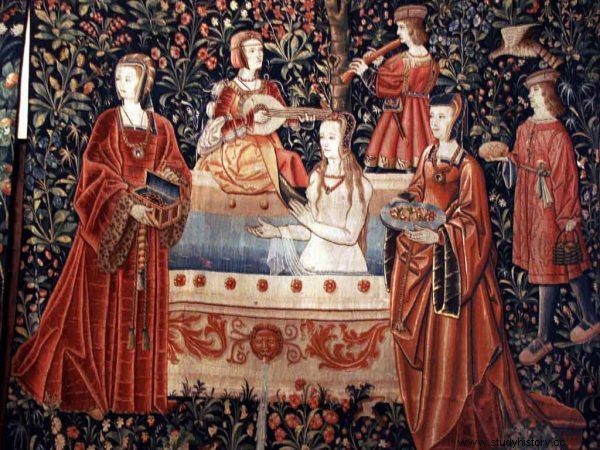
There is nothing like scent while bathing.
Already in the oldest records about the medieval Slavic region there are mentions of baths available to almost everyone. They were washed with lye, and in later centuries also with soap. In the outer bailey, these tabernacles were the size of residential houses! This is evidenced by the excavations in Gdańsk, where a 4.5 x 4.5 meter building with this application was discovered. What's more, taking care of hygiene did not end with washing. After bathing, perfumes made of floral oils, herbs and spices were often used (read more on this topic).
8. They drank beer on every occasion
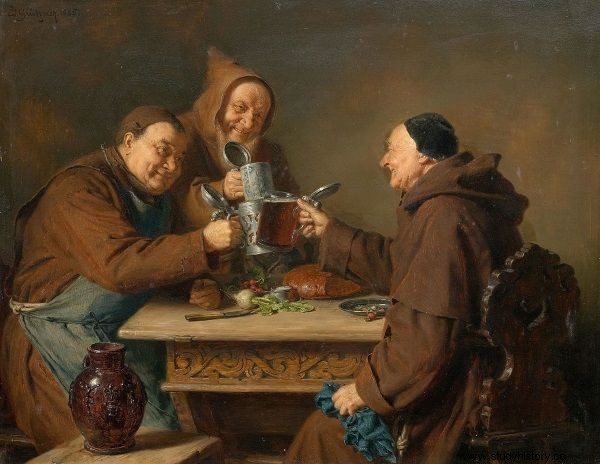
Beer was drunk by both kings and simpletons, not to mention the clergy.
In the 14th century, an average Pole drank over two liters of beer a day ! The golden drink was consumed for health reasons. The water was usually contaminated and its consumption could result in diarrhea at best. No wonder that even small children were served beer. Usually the army appeared there as well. Some say that it was the source of the success of our knighthood at Grunwald (read more about this).
7. They didn't make borscht from beetroots at all
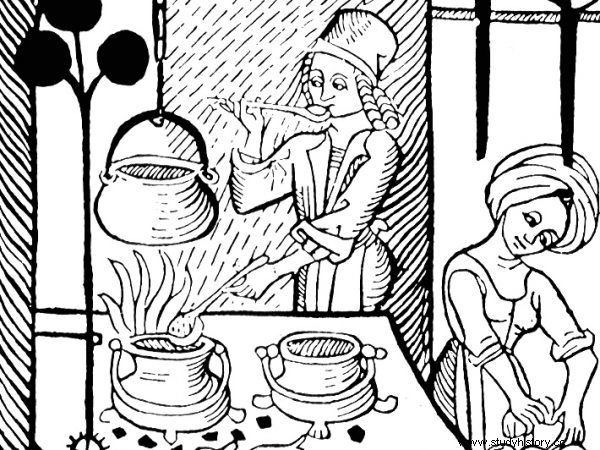
Was borscht being cooked here? Even so, it is definitely not beetroot! The woodcut is from "Kuchenmaistrey", the first cookbook to be printed in Germany published in 1485.
The beetroot borscht we know today, was alien to medieval cuisine. Originally, the dish with this name was made from a plant called borscht. The dish was extremely popular in Poland, Lithuania and Russia. This is how Marcin from Urzędów praised this soup in the 16th century:"Drink in fever, fever, and thirst, because thirst and cola are soothed, and greed for eating is stimulated with its spice" (read more on this topic).
6. They fasted for 1/3 of the year

During fasting, fish were eaten with pleasure. They also included beavers, especially their fish-like tails.
The medieval church imposed strict fasting. The ban on eating meat, as well as milk, cheese and eggs, was in force every Friday. Moderation was also often observed on Saturdays and Wednesdays. In addition, there is a period of Lent, Advent and the eve of major holidays. All these days together accounted for over a third of the year ! At that time, freshwater fish, fruit and vegetables and mixtum were consumed , that is, a peculiar "soup" of bread and wine (read more on this topic).
5. They enjoyed watching the execution sites ...
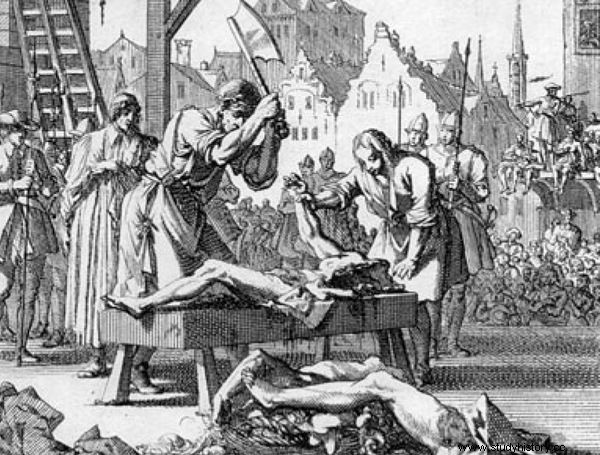
A good execution could not be complete without dismembering a half-alive body.
Crowded at the place where the traitors were executed, the audience was always waiting impatiently for the execution of the death sentence. The "spectacle" usually involved hanging, beheading and dismembering. The crowd also recreated this scenario on their own during the lynchings. For example, in 1476, the body of the Milan conspirator was wandered around the city streets, then hung by one leg on the scaffold, finally cut into pieces and thrown to pigs to be eaten (read more on this topic).
4. … And freak shows

The blindness of Ailward of Westoning, whose eyes were later miraculously regenerated (Canterbury Cathedral stained glass).
In 1159, one of the knights of Emperor Frederick Barbarossa was brutally deprived of arms and legs in Crema. He was forced to crawl through the streets of the city, to the general amusement of its inhabitants. In the late Middle Ages, mutilations performed in public took the form of a performance of justice. And paid "insane shows", attracting entertainment-hungry townspeople, were organized even in the oldest home for the mentally ill in Europe (read more on this topic).
3. They fell victim to love potions with a disturbing composition
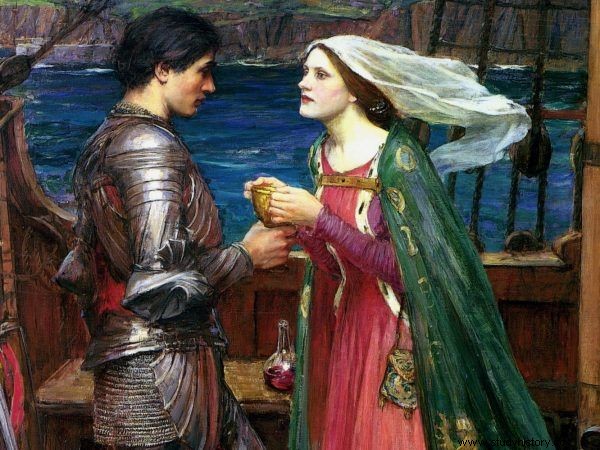
The specifics from the herbalist could work wonders. Tristan and Isolde found this out. A painting by John William Waterhouse from around 1916.
Medieval couples, a bit tired of each other, tried to enliven their sex lives with aphrodisiacs, prepared from the bones of the dead, graveyard trees and urine-sprinkled nettles . To arouse male interest, women also used another unusual cocktail:a drop of their own blood mixed with verbena, lovage and lily of the valley. The mixture had to be burned with an ash sprig, and the resulting powder should be thrown into the drink by my husband (read more on this topic).
2. They had ways to "restore" the lost virginity
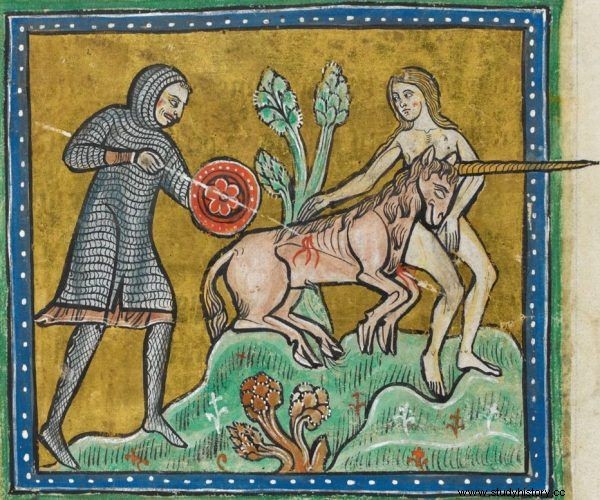
However, if the husband discovers that the wife is not spotless, the reaction can be drastic ... A virgin tame unicorn that has been hunted by the Rochester Bestiary.
The 11th-century Italian physician Trota of Salerno advised the virgins who "lost the wreath" to apply leeches to their intimate parts in order to "reseal the female vulva." On our wedding night, it helped to act intact. The arsenal of specifics did not end there. Miraculous preparations based on deer fat, lizard fat, salt, and even ... sulfur and mercury (read more on this topic) were also applied to the intimate places.
1. They could be zoophiles

Zoophilia could start with innocent kisses ... and end up with severe punishment. Miniature from "Topographia Hibernica" by Gerard of Wales, early 13th century.
Already in the 7th century, the monk and scholar Jan Klimak believed that the threat of zoophilia lurked at every step. Certainly, this deviation was an inseparable part of life in the countryside. Apparently, over half of the members of traditional communities had intercourse with animals . Zoophilia was treated as the third most serious sin in the field of sexuality, after oral and anal intercourse. Thirteenth-century Friesian law stipulated three possible penalties for him:castration, burial alive or burning at the stake (read more on this).
